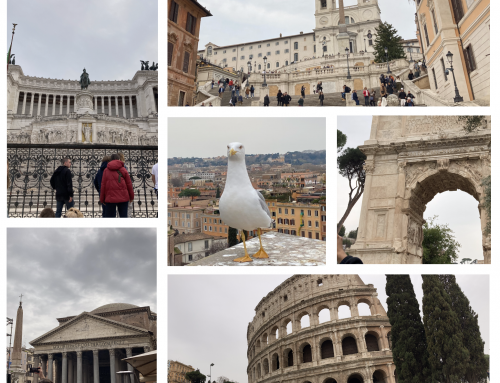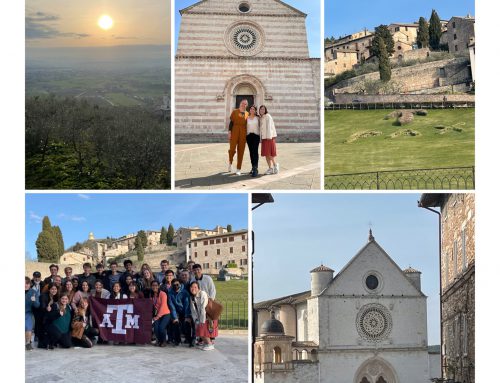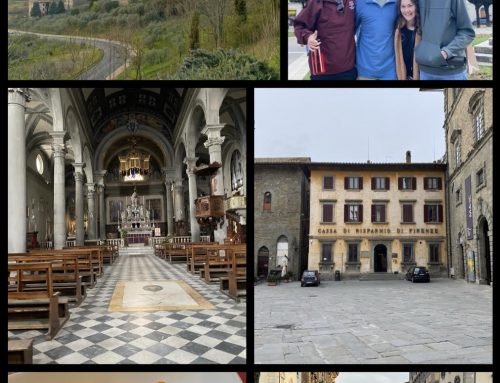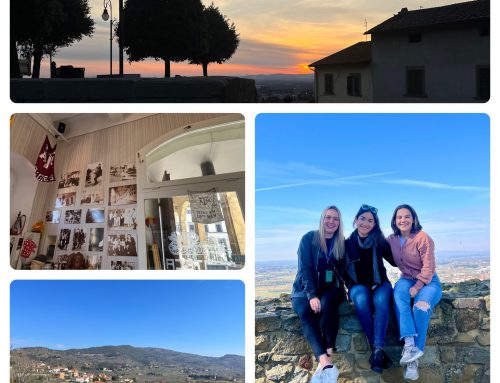We started the day early, at 7:30 am. We ate breakfast in two groups and fueled ourselves for the day with croissants, formaggio, prosciutto, coffee, and bread. As a part of group one, we left for our tour of the Accademia Gallery at 8:30 am with our amazing guide Marco. Along the way, he showed us many places and told us the inside scoop of art and architecture in Florence. In the Accademia, we started by going through a metal detector and receiving tickets with the face of Michelangelo’s David. Even the ceiling of the ticket room was painted beautifully. First we walked through a gallery of paintings and one statue, we learned about the revolutionary discovery of perspective in paintings. All of the colors are still beautifully vibrant and the attention to detail is extreme. We then traveled to the room where Michelangelo’s David is housed. Marco mentioned that The David is meant to be seen from 80 meters away, so that the proportions appear correctly. From this perspective, David appears confident and calm, as he prepares to slay Goliath, but from the side he’s staring off to, you can see the apprehension in his eyes. We discussed the techniques of Michelangelo by observing his unfinished projects, halted by the death of the pope that commissioned them. He did not use plaster models, as many students later did. To be in the presence of such famous art was breathtaking, and an experience we will never forget.
Our guide, Marco, took us around the Baptistry of St. John, the Santa Maria Cathedral and the Brunelleschi Duomo. The baptistry was built before the Cathedral in the 12th century. It is octagonal and held services before the church was built. It looks a lot more simple and is called “Romanesque” because it was inspired by the romans. The significance of the octagonal shape is because 7+1 is 8, seven days of creation and then the one added on represents Resurrection Day since Jesus appeared to the Apostles on the eighth day. Ghiberti designed the gilded bronze door with stories from the bible. It was in the renaissance style with grotesque elements. Bruneschelli designed and built the duomo on Santa Maria Cathedral. We climbed up 463 steps through the Duomo. On the way up we saw statues of the Holy Bishops that were sculpted by Peter Francavilla and Antonio di Annibale Marchissi, and statues of saints by Giovanni Caccini. The view of Florence was breathtaking, we had a 360 view of the city and could see all the churches, houses, and stores around the city as well as the countryside outside of Florence. On the way down we saw a collection of the tools they used for construction, restoration, and maintenance of the Duomo. After visiting the Duomo we all got gelato at Edorado il Gelato Biologico.
After visiting Brunelleschi’s dome, we visited Piazzale Michelangelo in the southeastern part of Florence. Upon reaching the top of the hill, we were rewarded with a magnificent view of all the rooftops of Florence. The scene included sights of all the major monuments in town and was completely breathtaking. After visiting the piazza, we wandered through the city streets, taking pictures and exploring more museums and courtyards as typical tourists would do. Although the city streets were busy, there is a very welcoming feel in the city that I think anyone could get used to.
“Past the bridge, up the grassy green hills of the beautiful city of Florence, there lies Piazzale Michelangelo. After a steep climb of the many hard rock stairs, and lots of catching your breath, one can be rewarded with one of the most beautiful views of Florence. The burnt red roofs, tall bell towers, and the ever-present roundness of the Duomo are all visible from the vast expanse of the piazza.” – Dani
– Sebastian Luna, Daniela Martinis, Sofia Campos, Audrey Helbert







